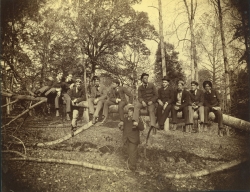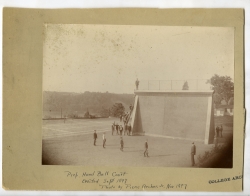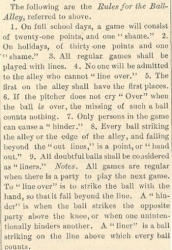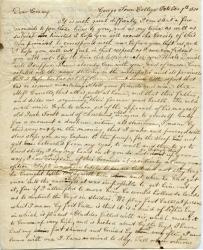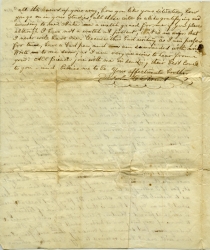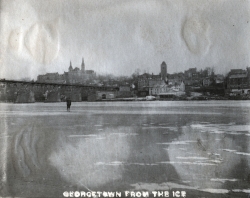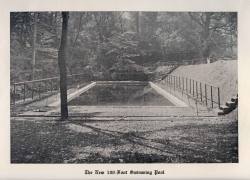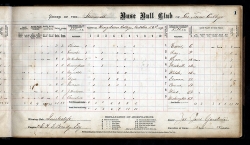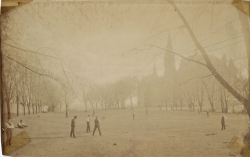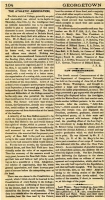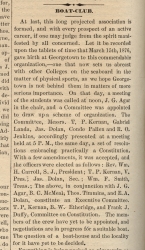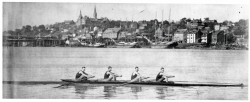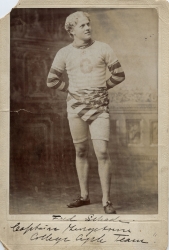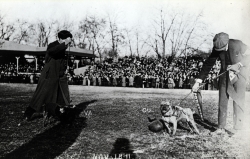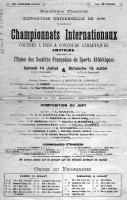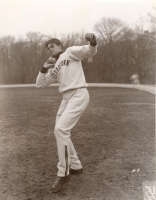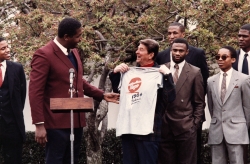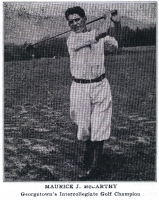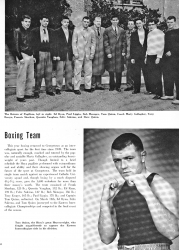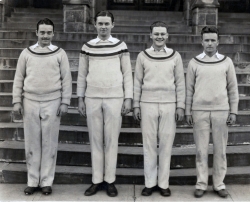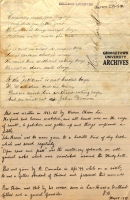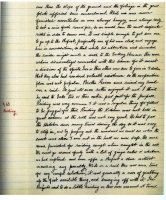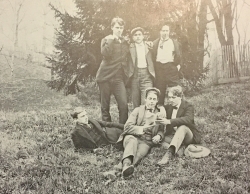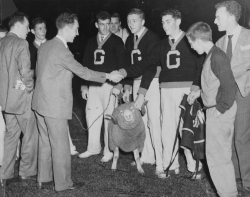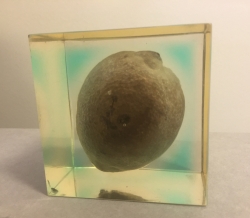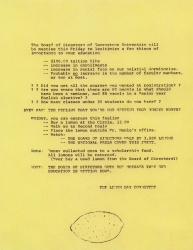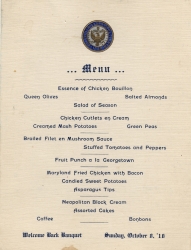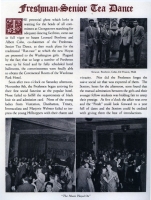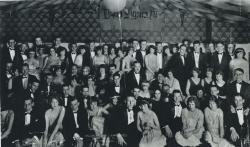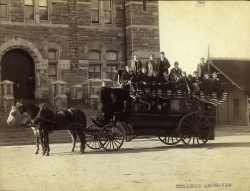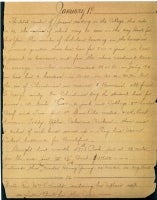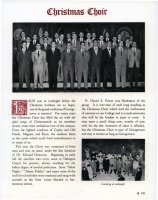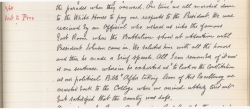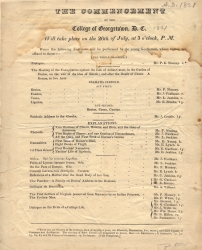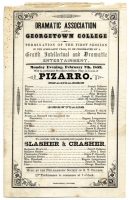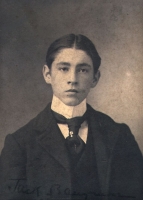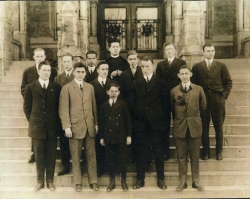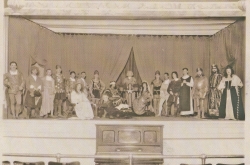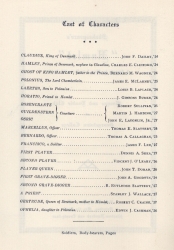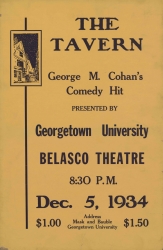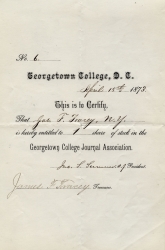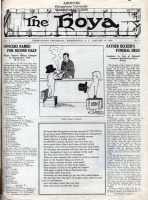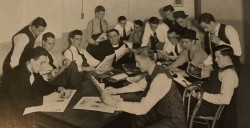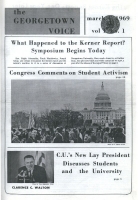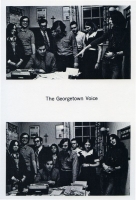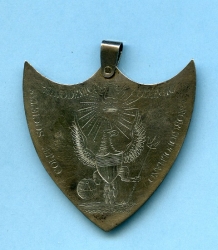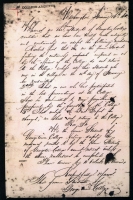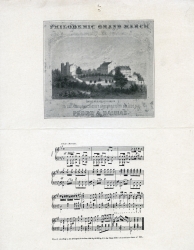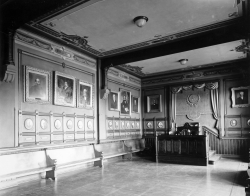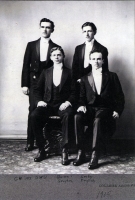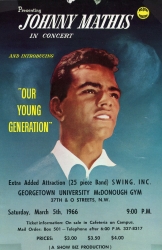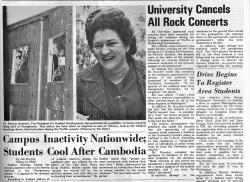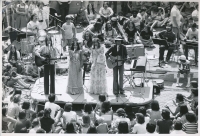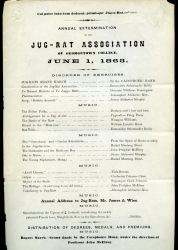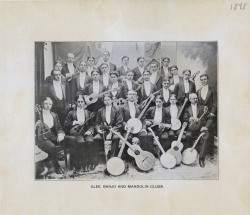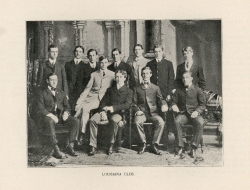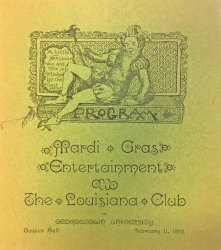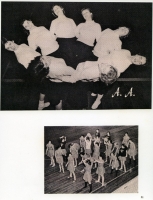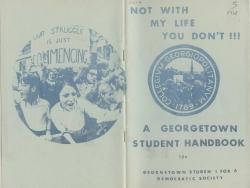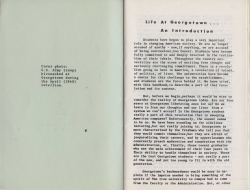Students relaxing on the Walks, 1895
The Walks (a series of connected paths around campus which were terraced and landscaped with trees) were laid down by Brother Joseph West in the 1820s. They became an important part of campus life, offering an escape from the restrictions of school discipline.
20th-century development on campus, beginning with the building of Copley and White-Gravenor Halls in the 1930s, encroached on the Walks and eventually obliterated them.
Map of the Walks, drawn by Fr. O’Leary, ca. 1960
Handball court, 1897
This handball court was on the south terrace, on the site of what is now Village A. The playing of handball on campus dates back to 1812, when a court was constructed near the present location of Healy Hall. Games, contested by an even numbers of players, would last about twenty to thirty minutes. The Georgetown College Journal of March 1877 noted that: [In the 1850s] so great was the zeal for ball-playing, that not only were both sides, but also the two ends of the alley played on at every recreation . . . Many a time could a large crowd, not only of students, but of towns-people also, be seen intently watching the progress of a game.
In addition to serving as an athletic venue, the handball court served a secondary purpose, as a favored site, protected from the eyes of University authorities, where disputes between students were settled with fistfights.
Description of football in letter from John Carroll Brent, October 7, 1830
Brent was a student in 1830 and a relative of our founder, John Carroll. His letter provides the earliest description we have of “football” on campus. In the last six lines of the first page, he writes: We play football at present. What I mean by football is that a kind of leather bag in which is placed a bladder filled with air which causes it to bounce up very high and is kicked about by the boys. I have had my feet skinned and bruised by it very often. I am lame with one I have received today.
Skating on the Potomac before 1923
The bridge shown is the Aqueduct Bridge which was built in the 1830s, originally to carry a canal across the Potomac River to Alexandria. When the Potomac froze, skaters were able to avoid tolls on the bridge.
The Aqueduct Bridge was closed in 1923, after the construction of the Key Bridge.
Outdoor swimming pool. Pictured in the Georgetown College Journal, October 1915
As early as the 1830s, swimming in the Potomac was a popular summer activity for students. This pool, 100 feet long by thirty feet wide, was built in the summer of 1915 and was located close to the present site of Harbin Hall. It was filled in by 1951.
Scores for baseball game between the Quicksteps and the Stonewalls, October 26, 1869
Team sports did not emerge on campus until after the Civil War. By 1869, the College boasted two baseball clubs, the Stonewalls and the Quicksteps. Games were played on the field that later became Copley Lawn.
Informal baseball game, ca. 1886
It has been suggested that origins of the word, Hoya, which formed part of the college yell or cheer, Hoya! Hoya! Saxa!, can be linked to the Stonewalls baseball club. The theory is this: a student using a mixture of Greek and Latin (which were emphasized by the curriculum) dubbed the Stonewalls, Hoia Saxa. Hoia is the Greek neuter plural for what or what a, while saxa is the Latin neuter plural for large or rough rocks. Taken together, Hoya Saxa literally means what rocks – the suggestion being that the players were as hard as rocks. Others have speculated that Hoya Saxa referred not to the team but to its surroundings. As this photograph shows, home plate was near the stonewall that still stands along 37th Street.
“The Athletic Association.” Georgetown College Journal, July 1875
Note references to Gymnasts, Billiardists and Base Ballists, as well as to a soon to be organized Boat Club.
The Georgetown University Athletic Association, also known as “The Yard,” was the first club to bring together student representatives with varied interests for a broad purpose. In the first years of the 20th century, The Yard expanded its role beyond athletics, assuming responsibility for purely social events and organizing advisory committees on issues that impacted the entire student body. By the 1920s, The Hoya was referring to The Yard President as the official head of the student body.
“Boat-Club.” Georgetown College Journal, April 1876. Announcement of the formation of the Georgetown College Boat Club
At last, this long projected association is formed, and with every prospect of an active career, if one may judge from the spirit manifested by all concerned. Let it be recorded upon the tablets of time that March 15th, 1876, gave birth at Georgetown to this commendable organization . . .
Crew on the Potomac with the University in the background, ca. 1881
One of the Georgetown College Boat Club’s first actions was to appoint a Committee on Colors. Georgetown did not have colors in 1876 and it was felt that they were needed so supporters on shore could identify the team during races. An account of the Committee’s work in the Georgetown College Journal explains that the Committee, looking for colors to express the feeling of unity that exists between the Northern and Southern boys of the College, recommended the adoption of Blue and Gray. A subsequent College Journal describes how young ladies from the neighboring Visitation Academy immediately sewed a half blue, half gray banner, bearing the inscription Ocior Euro (Swifter than the Wind in Latin), and presented it to the College. The banner, now lost, was prominently displayed at commencements and other school events and its colors quickly became part of our tradition.
Fred Schade (LL.B. 1898, LL.M. 1899) “Captain of the Georgetown College Cycle Team”
Schade was the Champion of the South and the Intercollegiate Champion of America. Bicycles were introduced to the University in the 1860s by a resourceful businessman who brought a number to campus and rented them to students. By the 1890s, races, typically one and two mile competitions, were included in track and field days organized by the University. During on-campus meets, the cyclists competed on the University’s clay athletic track. The track, one quarter mile in length, was not well suited to cycling as it was a quadrangle rather than an oval and did not have banked corners, making for potentially dangerous turns.
Georgetown v. University of Virginia, November 18, 1911 Final score: Georgetown - 9; Virginia - 0
The University of Virginia was the opponent in Georgetown’s first intercollegiate football game held in the fall of 1889. The Hoyas defeated the visiting Cavaliers, 34-0, beginning a spirited rivalry. The annual Georgetown-Virginia game became the highlight of the football season, attracting as many as 5,000 spectators to campus.
Football was a very different game at this time. According to newspaper accounts, several games in the 1890s were played in near riot conditions. In the October 23, 1915 game against Army at West Point, circumstances required the referee to issue a ruling that biting, while not explicitly prohibited by the rules, did constitute unnecessary roughness.
Orange Bowl sideline pass, 1941
During the 1938, 1939 and 1940 seasons, the nationally ranked Hoya football team compiled a remarkable record of 23 wins, 2 ties and only 1 loss (inflicted by the Boston College Eagles who defeated Georgetown, 19-18, during the 1940 season.)
On January 1st, 1941, Georgetown faced Mississippi State in the Orange Bowl. Depleted by injuries, the Hoyas lost 14-7. Both of Mississippi’s touchdowns were unusual – the first came on a blocked punt and the second after a questionable pass interference call. Bob Addie, the Times-Herald’s football expert, wrote: The Hoyas’ dream of conquest was shattered, but their share of the day’s glory was almost as great as that of that conquering host. Georgetown neither flinched nor uttered cry when two heart-numbing breaks went against them in decisions that might well have reversed the result.
The 1940 Georgetown squad included nine players who later played in the National Football League: Al Blozis; Jim Castiglia; Jack Doolan; Jules Koshlap; Augie Lio; Al Matuza; Angelo Paternoster; George Perpich; and Ross Sorce. Castiglia, Doolan and Paternoster all played for the Washington Redskins.
Championnats Internationaux. Official program from the 1900 Paris Olympics brought back by Georgetown sprinter Arthur Duffy
Track and field began at Georgetown in 1875, under the auspices of the Athletic Association. Each November, an intramural track and field competition was held which expanded into an intercollegiate competition in the 1890s. The Olympic Games in Athens in 1896, the first of the modern era, appear to have gone unnoticed on campus. Not so the Paris Games four years later, at which three Georgetown sprinters Arthur F. Duffy (L’1903), William J. “Billy” Holland (M’1903), and Edmund J. Minahan (enrolled in the Preparatory Department, 1899-1902) represented the U.S. The trio won four medals in Paris – one gold, two silver, and one bronze. This still stands as the highest medal total by Georgetown athletes at any single Games.
Georgetown Indoor [Track] Meet, Convention Hall, Feb. 17, 1900. Poster by John E. Sheridan (enrolled 1895-1900)
Georgetown sprinter Arthur F. Duffy (L’1903) set a new world record (5.2 seconds) for the 50 yard handicap dash at this meet.
Alfred C. “Al” Blozis (C'1942), holder of multiple world records for the shot
At 6 feet 6 ½ inches and 248 pounds, Blozis’ size and strength earned him such nicknames as “Big Al” and the “Hoya Hercules.” Participating in 26 college track meets between 1939 and 1941, he never lost a shot event and held five world shot records concurrently, for the 16 lb indoor shot, the 12lb indoor and outdoor shot, and the 8lb indoor and outdoor shot. Right tackle on the Georgetown football team that went undefeated for 23 games and made an appearance in the 1941 Orange Bowl, he played tackle for the New York Giants after graduation.
After the U.S. entered World War II, each of the three branches of the military refused to induct Blozis on the grounds that he was too tall. He finally succeeded in joining the Army in 1943, after the height requirement was waived. Last seen on January 31, 1945, during the Battle of the Bulge when he set out in a snow storm to search for a missing patrol, Lt. Blozis was later declared killed in action. The Hoya said the following on May 11, 1945: “We could go on almost indefinitely, relating his deeds, telling how time after time, he broke his own world’s records in the shot put, how he astounded pigskinners with his amazing coordination and speed. But none of us will ever be able to express in words how really big a man Al was. They just don’t issue those kind of words. Some day his records may fall, some people may even forget him, but those who ever had contact with him, however little, will never forget him. For Al was too big. Maybe that is why God chose him”
First Annual Georgetown Prom. Benefit of the Crew at the New Willard, April 14, 1904. Poster by Stephen T. Lorando, ’05
This prom was attended by more than 300 people; music was provided by a section of the Marine Band.
The crew, at this time, was facing huge financial issues. It did not have enough money to buy land for a boathouse and lack of funding began to impact its competition schedule. In fact, the crew did not compete in Poughkeepsie, the venue for the nation’s prime intercollegiate regatta, in 1908 or 909 because of a lack of funding; correspondingly, interest in the sport began to ebb on campus. Crew was suspended in 1911 and not restarted until 1958.
“Collegians at Basket-Ball.” Clipping from The Washington Post, February 6, 1901
This account of an intramural clash between students in the Georgetown College Prep School (then still housed on campus) represents the earliest record of basketball activity found in the Archives. Although the clipping references plans to form a college team the following fall, it appears that this did not happen. It was not until 1906 and the hiring of Maurice Joyce as Physical Instructor that basketball took hold as a Georgetown sport.
Tryouts for the varsity basketball squad were held in December 1906. This squad defeated its first varsity opponent, the University of Virginia, on February 9, 1907. The score was 22-11 in favor of Georgetown. The choice to play Virginia was possibly a symbolic one. Eighteen years earlier, in 1889, the Georgetown football squad faced and defeated Virginia in its first varsity game by a score of 34-0.
NCAA commemorative soda bottles, 1984
On April 2, 1984, the Georgetown basketball team won the NCAA Championship, beating Houston, 84-75, in a triumph of teamwork, domination, and intimidation.
Presidential audience for NCAA Champion Hoyas in the White House Rose Garden, April 7, 1984. Photograph by William Auth
Left to right: Fred Brown; Coach John Thompson; President Ronald Reagan; Gene Smith; Ralph Dalton (at the back); manager George Jackson; and Reggie Williams.
April 7th, 1984, was officially designated Georgetown Hoya Championship day in Washington. The day began with a presidential audience in the Rose Garden. You’re the first team from the northeast to win the NCAA Championship in 30 years, President Reagan commented. The Hoyas then participated in the Cherry Blossom Parade and ended the day with a ceremony conducted by Mayor Marion Barry on the steps of the District Building. The Mayor presented Coach Thompson with the key to the city.
Georgetown’s National Intercollegiate Championship Rifle Team, 1923. Ye Domesday Booke, 1924
Front row, left to right: William C. Saffarans, Washington, DC; Robert C. McCann, Bangor, ME; Sgt. Michael J. Donahue, U.S. Army Team Coach; Gerard J. C. Guilfoyle, Washington, DC; William H. Amend, New York, NY; John N. Doran, Waterbury, CT.
Back row, left to right: Walter A. Burke, New York, NY; Thomas A. Hayward, Washington, DC; Andrew J. Betz, Washington, DC; James E. Russell, Waterbury CT; Joseph W. Rouse, Orange, NJ.
The Georgetown University Rifle Club was established in 1920 under the auspices of the ROTC program, although membership was open to any Georgetown student. In March 1923, the team won the National Intercollegiate Championships of Rifle Clubs affiliated with the NRA. Georgetown accumulated a score of 3,934 out of a possible 4,000, the highest ever attained in the competition. The University of Iowa team with an aggregate of 3,879 was second.
Maurice J. McCarthy, Intercollegiate Golf Champion, 1928. The Hoya, November 1, 1928
An article in The Hoya of October 27, 1921, noted that: During the past summer a great number of Georgetown students took up the game of golf . . . Golf has come into great popularity throughout the entire country. It has ceased to be considered “an old man’s game . . .
The 1928 season marked Georgetown’s entrance into the Intercollegiate Golf Association. At season’s end, Maurice McCarthy, a sophomore, took the Intercollegiate individual title and, as a member of the Georgetown squad, finished second to Princeton in the team competition. The New York World newspaper described him as: one of the ablest match play golfers in the country [and] probably one of the half dozen most competent amateurs in the game. Indeed, McCarthy had come to national prominence in August 1927, when he almost defeated Bobby Jones (at that time British Open champion) in match play during the first round of the U.S. Amateur Championship.
McCarthy continued competitive golf after his graduation in 1930 and was a member of the victorious U.S. Walker Cup team of 1932. His name still appears in the U.S. Amateur Championship record books as winner of the longest match played – an 18 hole match against George Von Elm in 1930 which took 28 holes to decide.
Boxing Team. Ye Domesday Booke, 1955
In October 1892, the first boxing club was formed at Georgetown. Unable to sustain momentum, the club disbanded until 1920s when it re-formed as the boxing and wrestling club. In 1947, boxing became a recognized varsity sport under the direction of Coach Marty Gallagher, a former professional Washington heavyweight.
As a senior, Thomas M. “Tom” Quinn, pictured bottom right, entered the Eastern Intercollegiate Boxing Championships and won the heavyweight title. In the first round, he defeated the tournament favorite, Nick Georgiade of Syracuse, who had won the European heavyweight title while in the army. Coach Gallagher recalled in a Washington Post interview in 1967 that: Quinn did not come to Georgetown on an athletic scholarship and had no previous boxing experience but he was a natural and developed a punishing left hook . . . he was the best college boxer I ever coached and one of the best I ever saw.
Songs. Georgetown v. Virginia, November 15, 1913
An important part of athletic competition has always been support from the audience. This song sheet printed for the Georgetown v. Virginia football game in 1913 includes the original version of our alma mater, then called “Sons of Georgetown.”
Georgetown University cheerleaders, including Ernest J.L. Duhaime (far left) and Thomas A. McDevitt (far right), ca. 1929
Where there are cheers, there are cheerleaders. It was not until the 1950s that women served as cheerleaders on campus. Before that time, male students undertook the duties.
Poem passed around the study hall, ca. 1867
This poem, criticizing food on campus, was written by student Walter Chism during the 1867-1868 academic year. Close observers will see from the creases that the poem has been folded. Notes added at the bottom in the hand of Francis A. Barnum, S.J, who became University Archivist in 1898, explain that: Open, read and pass [a notation on the back of the poem] was the customary formula on all general notes which were circulated around the Study Hall – a practice that was strictly against the rules.
Account of pie stealing from Francis A. Barnum, S.J.’s memoirs, Student Life at Georgetown in the Late [Eighteen] Sixties
Raiding the kitchen to supplement a repetitive and at times unsavory diet was a regular occurrence in the mid-19th century. Fr. Barnum recounts how students used to steal pies – with a little help from the baker: Georgetown College pie was an institution, it was made from dried apples and formed the staple dessert for the entire year. It was made by Bro. Gavan and like everything from his bakery was excellent . . . Bro. Gavan was very stout and very good natured and furthermore he never looked on the boys as his natural enemies. When he spread out a long row of pies to cool he was certainly well aware that it was placing a great temptation in the way of youth . . . Brother Gavan never raised any howl over a raid. The good old man rather enjoyed it and I think he used to make two or three extra pies just for that purpose . . .
“Feeding the Prisoner.” Scribner’s Monthly, September 1880
A common punishment for breaking University rules was memorizing lines in Latin. A student who refused to cooperate with this punishment might find himself banished to a locked room (known as the Carcer) in the west tower of Old North, where he remained on a diet on bread and water until he felt more inclined to comply. Other members of the student body, however, were given to supplementing the prisoners’ meager diet, as illustrated by this Scribner’s article.
Student group, ca. 1910
Students in this photograph are, most likely, breaking several college rules. According to regulations enforced at the turn of the 20th century: Smoking is forbidden at all times and in all places to the junior students, and is allowed to the senior students only in places designated for that purpose . . . and it is considered a grave offence to introduce into the College novels or other books foreign to studies without the approval of the Prefect of schools. Such approval must be secured expressly and before the book may be used by any student.
Wooden templates for the hands to the Healy Hall clock, used by Facilities to fabricate new hands when needed, ca. 1965
In the 1960s and 1970s, the stealing of the hands from the Healy Clock by freshmen at the beginning of the fall semester was an annual tradition. During the 1968-1969 academic year, the hands were stolen so frequently that the University administration made a decision not to replace them and left the clock face bare. At Christmas 1973, a group of students stole the hands, spray painted them red and white so that they resembled peppermints, and returned the hands to the clock.
“Dr. Ruby Tells Rare Incident.” The Hoya, March 19, 1953
Many U.S. Presidents have visited Georgetown, beginning with George Washington in 1797. However, Woodrow Wilson is not one of them. This article recounts how the University was tricked by a student into expecting a visit from the President in 1918, after the Students’ Army Training Corps was inaugurated on campus.
Georgetown students return Rameses, the Fordham mascot (kidnapped from the Fordham campus days earlier), during the Georgetown v. Fordham football game, October 12, 1946
Four Georgetown students drove a car with a trailer attached to the Fordham campus and kidnapped the mascot from the baseball field where it was grazing. The ram was put on display in Gaston Hall the night before the game. Georgetown won the match-up played at Washington's Griffith stadium, 8-7.
“Want Woes? Try Stealing Live Wildcat.” The Washington Post, November 8, 1947
Georgetown played Villanova at football on November 14, 1947. A week prior to the game, a group of Georgetown students drove to Philadelphia and “catnapped” the Wildcats’ mascot (a bobcat named Count Villain III). The cat was kept in the basement of Healy Hall. The article poses the question: How do you keep a wildcat entertained for a whole week? Sadly, it does not answer it.
Note the fact that the Georgetown mascot at this time was a Great Dane named Butch. Georgetown students did not select the bulldog as their mascot until 1962.
Villanova defeated Georgetown in the game, 14-12.
John Carroll statue, December 13, 1967
The statue of our founder, John Carroll, has welcomed those entering campus through the University’s main gates since 1912. These photographs, taken at 8:35 a.m. on Wednesday, December 13, 1967, show two students applying a coat of red paint to the statue. The damage caused by the paint contributed to the need to be totally restore the statue – at a cost of close to $10, 000.
“Epidermist Film Crew on Campus.” The Hoya’s April Fools’ issue, April 1, 1973
The first April Fools’ issue of The Hoya appeared in 1954, reporting, among other things, that Mount St. Mary’s College, Emmitsburg, Maryland, had recently been discovered to own the Georgetown campus and that five extra days had been added to the Easter vacation.
This article was clearly inspired by the filming of scenes for the movie, The Exorcist, on campus the previous October.
Lemon encased in acrylic, 1973
This lemon was a participant in the “lemonstration” of February 2, 1973, during which students placed around 6000 lemons against the door to the President’s Office, while the Board of Directors was meeting inside. The students were protesting proposed increases in tuition and board and rising enrollments. Lemons were sold by student vendors in front of Healy Hall, who hawked their wares by shouting slogans such as: Buy a lemon. Show the Board of Directors your education has gone sour. Student body president John B. Kennedy estimated that about 50 percent of the student body took part in the protest.
Undeterred, the Board approved the increases.
Welcome Back Banquet menu, October 8, 1916
Traditionally, the entire undergraduate student body (in 1916, this totaled 236) would celebrate the beginning of the new academic year with a banquet.
In 1916, classes began on the afternoon of September 27 and the welcome banquet was held on October 8. The October 1916 issue of the Georgetown College Journal described it as follows: This occasion fully measured up to those for which Georgetown is famous, and was thoroughly enjoyed by all, especially the Freshmen, who were shown for the first time a real example of Georgetown spirit. Cheers were given, first for the football team as a whole, and then for the individual members who participated in the Navy game [the first football game of the season, played on October 7]. Songs were frequent and spirit ran high.
Freshman-Senior Tea Dance, November 8, 1947. Ye Domesday Booke, 1948
With no women students in the College (they were not admitted until 1969) and only a few women enrolled in the School of Foreign Service, it was necessary for Georgetown students to organize social events, such as this tea dance, so that they could meet women from other Washington schools.
Halloween Dance held by Mu Chapter of Delta Sigma Pi, November 1924
Delta Sigma Pi, a professional international fraternity in the field of business and commerce, was founded in 1907. Mu Chapter was founded at Georgetown on June 8, 1921.
Program for The Critic or A Tragedy Rehearsed, November 28, 1888
By the 1850s, Thanksgiving or “Yankee Christmas” as it was also known, was celebrated on campus. A play or concert was traditionally put on by students on Thanksgiving Eve.
Among The Critic’s cast appears the name of John V[inton] Dahlgren (C’1889, L’1891). Mr. Dahlgren and his wife, Elizabeth Drexel Dahlgren, paid for the construction of Dahlgren Chapel, which was dedicated in 1893. In addition to being the first building on campus named after a non-Jesuit, the Chapel was the first to be funded exclusively by outside gifts.
Supporters preparing to leave campus for the Thanksgiving football game, 1894.
After the introduction of football in the 1880s, an annual Thanksgiving game was played. The 1894 game, played against the Columbia Athletic Club, did not end in the same festive way it began. According an account in The Washington Post, the play in the game was the fiercest ever seen in Washington and the list of injured was the largest. Football was suspended after the game and play did not resume on campus until 1898.
Football from the Thanksgiving game, November 29, 1906. Final score: Georgetown – 16, George Washington - 6
Diary of John McElroy, S.J., January 1, 1813, including a description of the Christmas Day menu
With travel slow and difficult, it was expected at this time that the student body would spend the holidays, including Thanksgiving and Christmas, at the University.
Fr. McElroy makes no comments on the quality of the Christmas fare but other documents in the Archives from this period do cast the food on campus in a negative light. Archbishop John Carroll, the University’s founder, wrote to the University President John Grassi, S.J., on October 30, 1812: Never relax in your attention to the neatness and cleanliness of the College, & the personal neatness of your scholars; & to their diet. I know it is good in substance, but I fear, your cook is deficient.
“Christmas Choir.” Ye Domesday Booke, 1948
Each year at midnight before the Christmas holidays are to begin, one of the grandest traditions of Georgetown is renewed. For many years, the Christmas Choir has filled the air with glad songs of Christmastide as its members slowing make their melodious tour of the campus . . .
The Junior Prom, February 1951. Ye Domesday Booke, 1951
Ticket to the Senior Prom, April 20, 1914
Invitation to the Philodemic Society’s July 4th celebration, 1833
In addition to honoring George Washington’s birthday, the Philodemic Society also organized a celebration for July 4th. It was common for distinguished speakers to be invited to participate. A favored guest was George Washington Parke Custis, the adopted son of Washington. According to an account in the Georgetown College Journal of February 1907, on one exceptionally hot 4th, sometime in the 1850s, Mr. Custis’ remarks outlasted the audience’s interest: despite the usual devices employed to bring [him] to a full stop, to-wit, vociferous applause, shrill cries and even cat-calls. As a final means to bring on the peroration of his eloquent address, the brass band . . . was sent out into the quadrangle to drown out the speaker.
Description of student visit to the White House from Francis A. Barnum, S.J.’s memoirs, Student Life at Georgetown in the Late [Eighteen] Sixties
In the early years of the University, students were rarely permitted to leave campus unaccompanied. However, walking excursions – in the company of a Jesuit Prefect – on holidays to sites in Washington were not infrequent. This extract describes a visit to the White House during the presidency of Andrew Johnson (1865-1869):
Section 60 Visit to Pres
One time we all marched down to the White House to pay our respects to the President. We were received by an official who ushered us into the famous East Room where the Battalion stood at attention until President Johnson came in. We saluted him with all the honors and then he made a brief speech. All I can remember of it now is one sentence wherein he exhorted us “to look on the Constitution as our political Bible.” After taking leave of His Excellency we marched back to the College where we arrived utterly tired out but satisfied that the country was safe.
Commencement program, 1821
Plays have been put on by Georgetown students since the 1790s but the two-act drama about the life and death of Julius Cesar which opened the 1821 commencement ceremony is the first recorded play performed for visitors to the college. Note the fact that the performance gets top-billing over the presentation of diplomas and also that the names of the graduates, unlike the names of the actors, are not recorded.
Constitution of the Dramatic Association of Georgetown College, 1853
In 1853, a dramatic troupe was officially established on campus. The first article of the Association’s constitution reads: This association shall be called the Dramatic Association of Georgetown College. It professes to hold Elocution as the primary object of its cultivation.
Handbill for Pizarro, performed on February 7, 1853 by the Dramatic Association
Sheridan’s Pizarro was the first show put on by the new Dramatic Association. Listed among the names of the student cast are James R[yder] Randall (who attended 1848-1856), author of Maryland, My Maryland, and Hugh J. Gaston (who attended 1848-1855), grandson of our first student, William Gaston.
No tickets were printed for the early shows of the Dramatic Association. Plays were seen by invitation only and an Invitation Committee compiled guest lists and sent out invitations.
John Barrymore, 1897
Among the professional actors who have attended Georgetown, the most famous is probably John Barrymore, who enrolled in 1895. Play programs preserved in the Archives show that Barrymore, a member of a famous acting family and grandfather to actress Drew Barrymore, performed in plays while a student.
A Georgetown College Journal article from February 1933 quotes an interview with Barrymore in which he says that when he first got to Georgetown: a priest took me through the buildings. I paused in the gymnasium to swing on the parallel bars and as I turned over there fell out of my pockets a razor, a dime novel, and half a pint of whiskey. The mishap gave the priest more information than I could have supplied in 80 confessions. They were very kind to me at Georgetown and although they eventually expelled me, they did it in a nice way.
Program and typed expense report for New York performance of All the Comforts of Home, March 31, 1910
In 1910, after a period of obscurity, the Dramatic Association was reorganized through the efforts of Edmund A. Walsh, S.J., for whom our School of Foreign Service is named. The first production put on by the revitalized group was All the Comforts of Home, a farce by William Gillette. The show was so well received that Fr. Walsh, working with the Alumni Association, arranged to have it put on in New York, in the Astor Room of the Waldorf Astoria Hotel.
Georgetown University Dramatic Association, ca. 1913
Pictured in the center of the last row is Edmund A. Walsh, S.J.
The Association adopted a new name in 1919 – the Mask and Bauble Club. The name was chosen to reflect that the Club would perform both tragedy and comedy.
Cast of Hamlet, presented by the Mask and Bauble Club, May 10, 1924
Close scrutiny of this photograph will reveal that the female parts were performed by male students in female garb.
Poster for Mask and Bauble performance of The Tavern, December 5, 1934
The Tavern appears to be the first performance by a Georgetown drama group to include women in the cast. Students from Trinity College played the female parts.
Three weeks before the performance, the play's author, George M. Cohan, whose son, George, Jr., was a student at Georgetown, visited the cast unexpectedly and helped them rehearse. He later commented to reporters that the student performers constituted the best amateur talent he had seen.
Photograph inscribed: To the Masque [sic] and Bauble Club of Georgetown University, with appreciation for lending your time and talents to the White House Festival of the Arts, and with best wishes, Lady Bird Johnson [1965]
During the Kennedy and Johnson administrations, Mask and Bauble provided lighting for a number of opera, ballet, and theater productions in the East Room of the White House and on the White House Lawn. The Festival of the Arts, held on June 14, 1965, lasted over 12 hours and was attended by more than 300 artists, art patrons, and critics. The program ranged from pop art and jazz to poetry readings and ballet.
Cover of the Georgetown College Journal, April 1947
The inaugural issue of the Georgetown College Journal, the first printed newspaper produced by Georgetown students, appeared in 1872. After The Hoya appeared in 1920, the Journal ceased to carry campus news and turned its focus to literary and opinion pieces.
Stock Certificate for one share in the Georgetown College Journal Association, purchased by the Association’s treasurer, James F. Tracey, 1873
In its early years, the Journal struggled to find sustainable sources of operating revenue. A number of benefit concerts were staged and stock in the Association was sold for $5 per share. Student stockholders received one vote in the Association, three copies of each issue of the Journal, and the right to a mail subscription for three consecution years after leaving Georgetown.
Robert J. Collier (C’1894) and Conde M. Nast (C’1894), photographed in 1894
Among the staff of the College Journal in the 1890s were two students who went on to significant careers in publishing, Robert Collier and Conde Nast.
Robert Collier, who wrote the words to our Alma Mater while a student, became editor of the Collier’s Weekly magazine which had been founded by his father. Noted for its half-tone news pictures, Collier’s Weekly flourished under his guidance, publishing the work of writers like Edith Wharton and P. G. Wodehouse, as well as submissions from journalists like Peter Dunne and Mark Sullivan.
After graduation from Georgetown, Conde Nast went to work as advertising manager at Collier's Weekly. In 1909, he bought Vogue, then a small New York society magazine, and transformed it into America's foremost fashion magazine. He went on to add a variety of publications to his empire, including Vanity Fair, House & Garden, and Glamour, which was the last magazine added before his death in 1942.
Letter from the Maryland Provincial Joseph F. Hanselman, S.J., to the University President Joseph J. Himmel, S.J., commenting on the possible inappropriateness of some content in the Georgetown College Journal, August 21, 1911
Not everyone was a fan of the College Journal, as this letter indicates. The Provincial begins: Comment has been made that poems and stories in our college journals and annuals deal too much with love as their main motive. Occasionally, too, though very rarely, objectionable pictures have appeared.
Sophomore Class Paper, 1912
Hand written class papers at Georgetown can be traced back to 1824 and the appearance of a publication titled Minerva. The practice continued into the 20th century.
The editor of this example notes: This paper will appear as a “weekly” every Tuesday afternoon at one o’clock to be absorbed during the English hour and the History hour – two classes to be ignored as no sophomore needs English and no sophomore learns History. Besides both subjects are easily gotten up the night before examination . . .
The Hoya, Vol. I, No.1, January 14, 1920
The Hoya first appeared on January 14, 1920, under the editorship of Joseph R. Mickler, Jr. It differed from previous student publications in its intent to be a comprehensive University newspaper, with coverage of the professional schools (at that time, Law, Dental, Medical, and Foreign Service), as well as the College. The intent to be comprehensive was reflected in the choice of the paper’s name, as the word, Hoya, was not exclusive to any group on campus.
Weathering the Depression, World War II, student unrest in the 1960s, and funding cuts in the 1970s, The Hoya has appeared more or less continuously since its founding, providing a student perspective on issues, events, trends and controversies that have impacted and molded the university and those associated with it.
The Hoya. Ye Domesday Booke, 1937
. . . [The Hoya] won the unstinted praise of Mr. Eugene Meyer, publisher of The Washington Post, who classified it as “one of the finest college newspapers I have ever seen. One that need never fear being exceeded by any other.”
The paper was produced in offices in Copley basement. The moderator of the paper at this time was Edmund P. Cerrute, S.J., who was assistant Dean of Discipline and Associate Professor of Religion. The post of moderator was held by a Jesuit. A member of the editorial board, his job was to read everything prior to going to press. The position of moderator was eliminated in 1980.
Interview with The Beatles. The Hoya, February 20, 1964
The Hoya has a long tradition of providing coverage and reviews of both on and off-campus entertainment, with reviews of off-campus plays and movies first appearing in 1929. One of the high points of The Hoya’s entertainment reporting came with this interview with The Beatles, who were in Washington for their first live concert appearance in the U.S.
Georgetown Voice, Volume 1, No. 1, March 4, 1969
The Georgetown Voice first appeared in March 1969, promising to present and analyze national and local issues of concern to the student, whose concern should spread beyond the campus.” The paper took its name from New York’s Village Voice.
In the 1960s, even in the midst of great change on campus, the editors of The Hoya continued their traditional focus on campus news and events. This editorial stance led to debate, both internal and external to the paper, over what its focus should be. A faction of students demanded that the paper provide more coverage of Vietnam War protests, accusing its editors of being too conservative and not adequately reflecting student opinion. One result of this debate was the founding of the Georgetown Voice.
Fool’n’Me . . . by David Hagen (G’1987), 1994
This cartoon, celebrating the 25th anniversary of the Georgetown Voice, appeared in the publication on March 22, 1994. David Hagen, now Lauinger Library’s Graphic Artist / Photographer, was a cartoonist for both The Hoya and the Georgetown Voice during his graduate student days.
Notes on Philodemic Society debates, September 1830
In the fall of 1830, a group of 33 students met to organize a debate society which was subsequently named the Philodemic Society of Georgetown College. The topic chosen for their first debate was: Who was the greater man, Napoleon Bonaparte or George Washington? Unsurprisingly, Washington was judged greater. Subsequent debate topics were: Whether the citizen or soldier be the more useful member of a republic; the comparative merits of the ancients and moderns; and which has more effect upon the heart of man, music or eloquence?
Philodemic Society Badge
At the fourth meeting of the new Philodemic Society, held on January 18, 1831, members resolved to adopt a badge to be worn by members on special occasions. This took the form of a two-sided shield. On the front, the American eagle appears, a trident in one claw and the other resting on a globe. On the reverse, Mercury (god of eloquence) clasps hands with the goddess of liberty. The shield bears a Latin inscription: Colit Societas Philodemica E Collegio Georgiopoliano Eloquentiam Liberati Devinctam. This has been translated as: The Philodemic Society of Georgetown College cultivates Eloquence devoted to Freedom.
Petition from students who left campus during the riot of 1850, stating the conditions under which they would return, January 16, 1850
In January 1850, while University President James Ryder, S.J., was away, the Philodemic Society sought permission to hold a meeting after studies on a Sunday evening. Permission was refused but the Society went ahead with the meeting. As a result, the First Prefect suspended Philodemic meetings for a month and deprived members of late study privileges. There were mass protests in the dorms and refectory against these actions, leading to the expulsion of three students on January 15.
In response, about sixty other students (out of a student body totaling 180) decamped to the Globe Hotel in Washington and issued an ultimatum that they would not return until they had amnesty and the expelled students were taken back. Fr. Ryder’s deputy responded by giving notice to the hotel that the students' bills would not be paid by the college and a team of Jesuit negotiators talked the students into capitulating, demands unmet, on January 21.
Philodemic Grand March, 1854
The illustration on the sheet music shows the campus from the northwest, with Old North pictured to the left and Old South (the first building on campus), Mulledy and Gervase to the right.
Philonomosian Society fines and membership book, 1852-1861
As membership in the Philodemic Society was limited to the senior class, debating societies for younger students were established, including the Philonomosian Society which was founded in January 1839. The Society levied fines on its members to enforce order, decorum and participation in debates.
Program from the first debate of the Philodemic Society for the Merrick Medal, February 23, 1875
The Merrick Debating Medal was founded in 1874 by Richard T. Merrick (H’1873), a well-known lawyer and orator. Merrick wanted to stimulate interest in the study and practice of public speaking among the students. He transferred $900 of Metropolitan Railroad Company stock to Georgetown, the revenues from which were to purchase the medal annually.
Merrick Medal
Struck from solid gold at the U.S. Mint in Philadelphia, the Merrick Medal was the most coveted prize at the University by 1900.
Georgetown University debate team, May 27, 1905
Shown before a debate against George Washington University are: William F. X. Geoghan (L'1906) and Charles H. English (L'1905) in the front row; Henry I. Quinn (LL.B 1904, LL.M 1905) and Michael J. Leahy (L'1906) in the rear. The debate topic was the open shop.
Program from the St. Cecilia’s Day celebration, November 22, 1873
St. Cecilia is the patron saint of musicians and church music. The College choir formed the St. Cecilia Society in the 1850s and held their annual celebration on St. Cecilia’s Day (November 22), performing in the refectory. In 1872, the celebration was taken over by members of the Rhetoric (Junior) class.
Tickets to entertainment for the benefit of the College Grand Stand, 1898, the Reserve Football Team, 1899, and Georgetown athletes competing in the 1900 Olympic Games
Benefit concerts were a common way of raising money for extra-curricular activities.
The Georgetown Collegians in Gaston Hall, 1929
The Collegians were organized around 1923. By 1930, they were so popular locally that they had a weekly Thursday night show on radio station WOL.
Chimes ’66 LP
Founded in 1946 by Frank Jones (LL.B. 1948, LL.M. 1952), the Georgetown Chimes take their name from the original tower bells of Healy Hall.
The Georgetown University Glee Club sings on the Ed Sullivan Show on CBS, Easter Sunday 1956. Backstage at the Ed Sullivan Show, Easter Sunday 1956. Ed Sullivan (far left); Georgetown University President Edward B. Bunn, S.J. (second left); and Paul Hume
This was not the first meeting for Fr. Bunn and Ed Sullivan – Fr. Bunn had baptized Sullivan’s first grandchild.
Handbill for Johnny Mathis concert in McDonough Gym, March 5, 1966
Beginning in the 1960s, campus was the venue for concerts performed by non-Georgetown performers, such as Ray Charles in 1964, Johnny Mathis in 1966, the Four Tops in 1968, The Who during Homecoming Weekend 1969, and the Grateful Dead who played for Homecoming in 1970.
"University Cancels All Rock Concerts.” The Hoya, November 19, 1970
After incidents at the Grateful Dead and Traffic concerts held in McDonough Gym on October 23 and November 15, 1970 respectively, University administration suspended concerts on campus. According to Vice President for Student Development Patricia Rueckel, this move was prompted by overselling of tickets, “flagrant violations of drug laws”, and “general havoc within the gymnasium.” The ban was lifted in November 1971 for a Beach Boys concert.
Starland Vocal Band tapes a segment for a CBS variety series in the Quadrangle, June 1977
Bill Danoff, (I’1968), founder of the Starland Vocal Band is pictured right (in the hat.) The group opened their set at Georgetown with their Grammy-winning hit, Afternoon Delight, which, according to an article in the November-December 1977 issue of the Georgetown Today magazine, Danoff was inspired to write from a menu at Clyde's on M Street. Danoff also co-wrote the song, Take Me Home, Country Roads, with John Denver.
Everything You Want, Vertical Horizon, 1999
A number of Georgetown alums have gone on to successful musical careers, including Bill Danoff (I’1968), Walter Egan (C’1970), Guy Picciotto (C’1987) of Rites of Spring and Fugazi, Keith Kane (I’1992) and Matt Scannell (C’1992) of Vertical Horizon, and Amerie Rogers (C’2000).
This CD, Vertical Horizon’s first release on RCA, sold more than 2,000,000 copies in the U.S. The second single taken from it, like the album called Everything You Want, topped the Charts and was one of the most played songs on the radio in 2000.
The Georgetown University Chamber Singers sing the Georgetown University Alma Mater at the White House, as President Clinton (F’1968), Mrs. Clinton and Chelsea Clinton look on, December 8, 2000
Founded in 1992, the Chamber Singers are a select group of mixed voices, specializing in the study and the performance of a cappella music from the 15th to 21st centuries.
Program from the Annual Extermination of the Jug Rat Association, June 1, 1863
Until the 20th century, punishment for rule breaking generally took the form of memorizing and reciting a set number of lines in Latin. When a student had lines to learn he was said to be in the Jug (or punishment room) and he was known as a Jug Rat. Lines were cumulative and it was possible for a student given to rule-breaking to be in the Jug for the entire school year. A Jug-Rat Association operated sporadically during the second half of the 19th century. When the Association was active, an annual “extermination” was held at the end of the school year. A program of music and speeches, this was a parody of commencement ceremonies and generally attracted large external audiences.
Words to the Charge of the Smoking Brigade, performed at the Extermination of the Jug Rat Association, June 29, 1864
This is a parody of Alfred, Lord Tennyson’s Charge of the Light Brigade, published in 1854. Tennyson’s version begins:
Half a league, half a league,
Half a league onward,
All in the valley of Death
Rode the six hundred.
"Forward, the Light Brigade!
Charge for the guns!" he said:
Into the valley of Death
Rode the six hundred . . .
Georgetown University Glee, Banjo, and Mandolin Clubs, 1898
In the 1890s, many colleges, Georgetown included, had banjo clubs. These performed orchestra-fashion, frequently pairing banjos with mandolins.
Program from Glee, Banjo and Mandolin Concert, January 15, 1902
Louisiana Club. Hodge Podge [Yearbook], 1902
Founded in 1901, this Club was limited to Louisiana residents. One of the highpoints of its social activities was its Mardi Gras celebration.
“Flask and Bottle Club.” Ye Domesday Booke, 1948
The name of the Mask and Bauble Club was parodied in the 1940s and 1950s by a group which took the name, Flask and Bottle. This was a loosely organized group of students who performed comedy skits at University gatherings, especially football rallies. All members of Flask and Bottle were elected Club president and its rules prohibited any script writing until twelve hours before a performance to enhance freshness and originality.
Note the inclusion of William Peter Blatty, author of The Exorcist, among the Flask and Bottle members.
Women’s Athletic Association. The Caduceus [Nursing School Yearbook], 1958
Women students at Georgetown did not begin participating in organized sports until 1952, when the Women’s Athletic Association (WAA) was established by a group of Nursing students. Its initial focus was on intramural basketball. Field hockey, swimming, tennis, horseback riding were later added. The Association was opened to women students outside the Nursing School in 1963.
Not With My Life You Don’t: A Georgetown Student Handbook by Georgetown Students for a Democratic Society, 1968
A Students for a Democratic Society (SDS) chapter was formed at Georgetown in 1968, headquartered at 3611 Prospect Street. On March 13, 1969, the chapter disrupted a lecture in Gaston Hall by San Francisco Mayor Joseph L. Alioto.
The core of the 1960s counter-cultural movement known as the New Left, Students for a Democratic Society (SDS) initially focused on Civil Rights. From 1965 on, the organization became more militant as it protested U.S. involvement in the Vietnam War and adopted strategies such as the occupation of university administration buildings. By 1969, SDS had splintered into factions, the most notorious of which was the “Weathermen.”
SDS. View from the Outside, February 10, 1969
SOAK flyer, November 3, 1977
In March 1977, Dr. Henry A. Kissinger, former Secretary of State, accepted a joint appointment as Visiting Professor of Diplomacy at the Foreign Service School and as Counselor to Georgetown’s Center for Strategic and International Studies (CSIS). The initial appointment was for six months. Dr. Kissinger was then appointed University Professor of Diplomacy in the summer of 1977. The appointment was not without controversy and Students Opposed to the Appointment of Kissinger [SOAK] campaigned for a review of it on procedural and moral grounds. A group with the same name had earlier appeared at Columbia University while that school was negotiating for Dr. Kissinger’s services.
The actions of SOAK led to the formation of an opposition group on campus, Students Taking Advantage of the Kissinger Experience [STAKE.]
Curated by Lynn Conway, University Archivist

